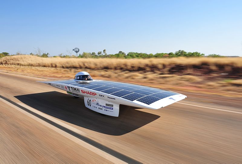 All eyes are on the victors and their vehicles as the Japanese solar car from Tokai University cruises over the finish line to take out the 2011 Darwin to Adelaide World Solar Challenge. Much like the Melbourne Cup, the winning teams and owners are interviewed, their conveyances hailed as wonders of the modern age and we all look forward to the next race. But then what?
All eyes are on the victors and their vehicles as the Japanese solar car from Tokai University cruises over the finish line to take out the 2011 Darwin to Adelaide World Solar Challenge. Much like the Melbourne Cup, the winning teams and owners are interviewed, their conveyances hailed as wonders of the modern age and we all look forward to the next race. But then what?
Twenty years after the first World Solar Challenge, solar panels have yet to make it on our everyday cars in a meaningful and viable sense and we still rely heavily on fossil fuels for our transportation needs. However the rigours of the race, through some of the most inhospitable terrain on the planet, provides an excellent test for teams, who are sourced mostly from research institutions. Throughout the World Solar Challenge’s history it has flown the flag of sustainability and encouraged research into the future of alternative energy-driven vehicles.
“The World Solar Challenge promotes research into zero-emission transport solutions.” said a May 28 Business World Australia article.
“The Challenge, and its associated events, seeks to feature the many technologies that are designed to lighten the impact of transport on the environment.”
The report points out rightly that the issue of environmental sustainability is the major goal of the Challenge.
“In the business of sustainability, an integral objective is to do more with less. The World Solar Challenge shares this objective – doing more with less is their key mission. They seek to promote acceptance of environmental sustainability by showing the world what’s possible.”
The rules are tight for the 3000 km car race through the heart of Australia where the only thing found in abundance is…well…sun. From the World Solar Challenge’s website.
“Based on the original notion that a 1000W car would complete the journey in 50 hours, solar cars are allowed a nominal 5kW hours of stored energy, which is 10% of that theoretical figure. All other energy must come from the sun or be recovered from the kinetic energy of the vehicle.”
But, what of the future? Will these technologies find their way into ordinary vehicles?
“They want technologies used in the Solar Challenge to find their way into the production cars of tomorrow,” said the Business World article.
Mark Borlace, technical services manager at the Royal Automobile Association of South Australia (RAA), agrees telling the Adelaide Advertiser in a 15 October report that the Challenge was a test for both solar cells and the cars’ battery technology.
“This race is one part of a whole quilt of things companies would do, but I think what separates this from the others is the length and weather conditions of our race make it a good test event for heat as a battery-killer, as well as the durability,” he said.
While it’s difficult to see us all driving solar cell cars in the near term, solar challenges such that between Darwin and Adelaide are providing the basis for the technology of the future. The recent unveiling of Mitsubishi’s first commercial electric car in Australia, the i-Miev, shows that battery technology is already well advanced.

 RSS - Posts
RSS - Posts



I think this is an amazing challenge. I imagine that it will bring solar power more into the public’s eye, and hopefully get more people interested in turning to solar power.